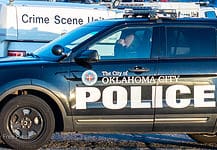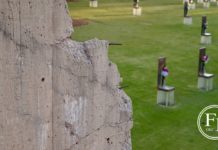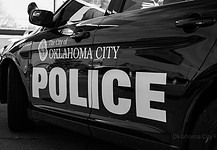Last Updated on February 22, 2018, 1:49 PM | Published: February 22, 2018
Tuesday, east-side Oklahoma City senator Anastasia Pittman recalled the damage done to her family by the 1921 Tulsa race riot, and so, was happy to see a new curriculum about it.
Pittman, who is black, told Free Press that her grandfather narrowly escaped the violence of the riot, one of the bloodiest events in the state’s history.

She stood next to Tulsa senator Kevin Matthews at the historically-black Douglass High School in Oklahoma City along with Oklahoma Senator James Lankford and other state officials to announce the roll-out of a new curriculum about the riot.
It has been developed by the 1921 Tulsa Race Riot Centennial Commission, established by the Legislature in 1997 and chaired by Matthews.
The curriculum is designed to help Oklahoma’s school children understand the massacre.
For legislative and personal reasons Pittman has been in full support of the commission’s efforts to develop a curriculum for schools to use in teaching Oklahoma history.
Along with many others of both parties, she believes that there needs to be more structure and intent when it comes to teaching about the 1921 Tulsa race riot for a full understanding of Oklahoma’s past and culture.
But the painful, personal reasons run deep, too.
Family connection
“My great grandfather, Abner Burnett, had a very profitable grocery store in the Greenwood district,” Pittman told us about her family’s Tulsa connection.
But, he is not a part of the official record of the riot because a phoned tip made it possible for him to get out the night before the burning and looting began, Pittman said.
Why did he get the tip?
“He was fair-skinned and didn’t look like an African-American,” she said. “He looked like a white man. And he was acknowledged as an honorable business man.”
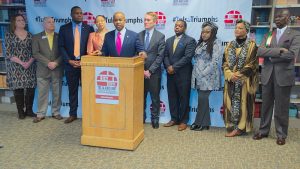
“He never went back to claim his property,” she said. “Like so many others, he had a family to take care of and was working hard to rebuild the business somewhere else.”
Her great grandfather took his family all the way to California to start over.
Pittman’s grandmother, named Tulsa Juanita Burnett Pittman, was only two years old when the family fled Tulsa with nothing but their lives and the things they could pack into their car that night.
“When she was ten years old she found out about their history and refused to use the name “Tulsa” from that point on,” said Pittman.
Instead of coming back to Tulsa from California, Pittman’s great grandfather came back to Oklahoma City to start a grocery store.
That’s why she grew up on the east side that she now represents.
The pain of that event did not cripple her family’s desire to succeed, but was an ugly stain on their past, placed there by the violence of whites.
Ugly secret
For years the spasm of white violence in 1921 was carefully kept quiet even among the black families who went from wealth to poverty in one day.
Whites wanted to move on because of shame and blacks because of their need to focus on survival and rebuilding.
But, because of the commission’s work, more of the public know sa part of Oklahoma’s ugly past that wasn’t taught at all until the 1990s.
New curriculum
It was with pride that Pittman stood next to Matthews Tuesday as the Chair of the 1921 Tulsa Race Riot Commission rolled out a curriculum that is the result of two decades of research.
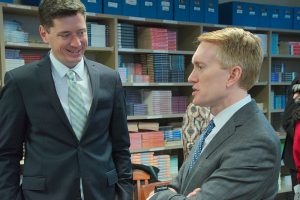
U.S. Senator James Lankford from Oklahoma, who is listed as a member of the commission, stood on the other flank of Matthews when the announcement was made.
“It’s not just about legislative issues, it’s a relationship issue,” said Lankford continuing his recent push for people of all races to get to know each other personally.
Teachers and others may access the curriculum on the commission’s website, www.tulsa2021.org.
Commission background
The commission was established by the Oklahoma Legislature in 1997 and resulted in an official collection of accounts and photographs from the riot.
They issued their final report February, 2001.
The Greenwood Cultural Center in Tulsa has a day-by-day account of the riot on their website.
The research has led to public acknowledgment and some apologies.
In 2013, Tulsa Police Chief Chuck Jordan officially apologized for the Tulsa Police Department’s inaction during the bloody days of the riot.
The Tulsa Police Department and the Tulsa County Sheriff’s Deputies did not attempt to stop the riot.
Riot background
By 1921, the Greenwood District in north Tulsa was one of the most prosperous business districts west of the Mississippi in legally-segregated Oklahoma.
It was referred to regularly up to the riot as the “black Wall Street of America.”
The black downtown of Tulsa along Greenwood Avenue rivaled the white downtown blocks away.
At that time, the black population of Tulsa was also growing close to the same numbers of whites in the city.
Both realities led to simmering resentment among a violent segment of Tulsa’s white community connected to the Ku Klux Klan.
Then, in 1921, a careless accusation by a white woman against a black man sparked a days-long coordinated attack on the district by whites.
Hundreds of black people were killed and the district burned including prominent black churches.
A large number of armed black WWI veterans had fought back successfully for a time.
But, they were eventually overcome when white members of the Tulsa National Guard unit opened their armory and brought heavy military weapons into the fight.
Order was only restored when the governor sent the Oklahoma City National Guard Unit.
Founder, publisher, and editor of Oklahoma City Free Press. Brett continues to contribute reports and photography to this site as he runs the business.



